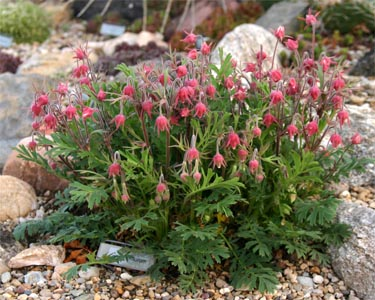Prairie Smoke

Prairie smoke or Geum triflorum is a North America native perennial that is one of the earliest blooming plants on the native prairie. It is widely distributed across the northern part of the United States but is hardy from zones 3-7 and is commonly found growing in the prairie or open woodlands. Unfortunately, this flower is becoming rarer as it is being out competed by naturalized invaders or eliminated by development. Prairie smoke forms a mound of foliage 6-10” tall and very slowly spreads via rhizomes. Leaves are pinnately compound with rather crowded, narrow toothed leaflets and the plant is semi-evergreen with foliage turning purple, red and orange from late fall into winter. When the plant is dry or during winter the leaves will flatten to the ground but perk up quickly when conditions improve. Prairie smoke has clusters of nodding reddish-pink, maroon or purple flowers on 12-18” stems. There typically are three flowers per stem, hence the species name. If the flowers are fertilized they form distinctive, silvery pink fluffy fruits that give the plant it’s common name as they look like smoke wafting away from the plant. The seed heads will remain on the plant for weeks. This plant is a great companion to spring blooming bulbs to fill in areas where the bulbs will die back in the summer. Prairie smoke prefers dry conditions but tolerates a wide range of soil types, especially in full sun. Keep away from plants that tend to be aggressive growers as it will be crowded out.

Have questions? Contact our office where our Horticulture Extension Agent will assist you with questions.
Phone: (316) 321-9660
Email: callae@ksu.edu